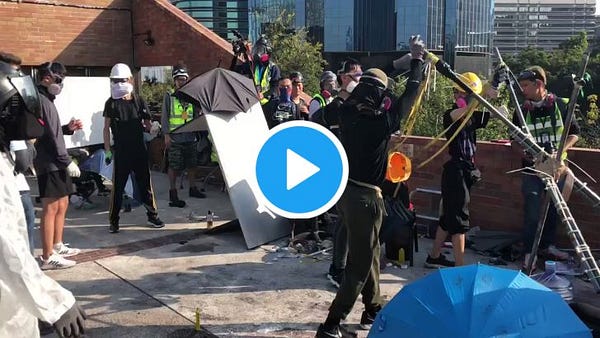Dear friends
This is A Procrastination, an email newsletter from Hong Kong: a City on Fire.
Last Monday night I wrote to you, perhaps slightly flippantly, “It may be another busy week.” If only I had known... Buckle up!
In this edition:
Hong Kong’s week of chaos
Inside the siege of PolyU
Hong Kong’s rule of law in the spotlight again
District Council elections
HK Update: The week Beijing let Hong Kong burn
I had been putting off writing this Procrastination until I finished an update on the past week for the New Statesman, just published yesterday: The week Beijing let Hong Kong burn.
In the piece I try to summarise the week of chaos Hong Kong has just endured (an attempt which one online commenter dismissed as “reductive,” which…I mean…guilty-as-charged, I guess) as well as take stock of where things stand. I conclude:
“With no signs of any compromise on the horizon, it appears that Beijing’s strategy for the moment is simply to let Hong Kong burn, with the expectation that the growing disruption and violence will ultimately undermine support for the protest movement, deepen the divisions in Hong Kong society, and create fertile conditions for Beijing to step in and impose order on a society-wide basis in the medium term. In the meantime, Hong Kong serves as a convenient object lesson for domestic propaganda purposes: look at what happens, Beijing can tell the rest of China, if you defy the Party.”
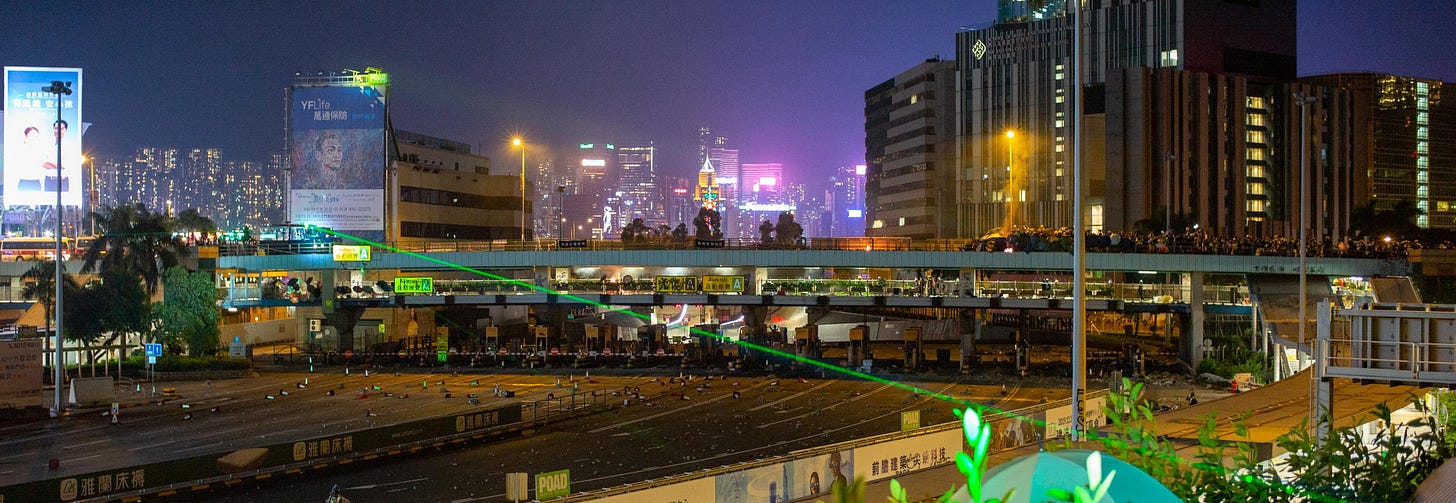
Police & protesters face-off on the bridge outside PolyU with the Causeway Bay skyline in the background.
I spoke to ABC Radio National’s Drive program to give an update on the latest from Hong Kong as of Tuesday afternoon. It’s a good ~5 minute overview of what’s been happening over the past few days: you can listen here.
And if you want a deeper dive, I gave two longer interviews over the past two days:
one giving some more details on the PolyU siege on The Current with Laura Lynch on Canada’s CBC radio (the first ~9 minutes of the segment): listen here
another giving some broader background to what led Hong Kong to this moment on Morning Wave in Busan on Korea’s BeFM Busan English Broadcasting (length ~16 minutes): listen here
Finally, I had an interesting conversation today with David Pierson of the LA Times, and offer a short excerpt for you to listen to here, in which I talk about the importance and role of an independent enquiry, the ominous possibilities for extremism going forward and the failure of government in Hong Kong (~5 minutes):
(Thanks to David for the conversation and for sharing his recording.)
Inside the Siege of PolyU
I arrived at PolyU on Sunday morning, shortly after the police assault on the campus began, and spent all day there, leaving later that night. The events of the siege itself have been well-reported in the media, but I thought I would share here a few impressions from inside the besieged campus:
Entering, I passed through a checkpoint manned by protesters who were frisking people and conducting bag checks, looking for undercover police officers who had been infiltrating protester groups.
Inside, the campus was a surreal experience: supplies and equipment were strewn everywhere, the walls covered in protest graffiti. The main courtyard was a hive of activity as protesters moved around supplies, prepared equipment, rested and chatted. Protesters on the site were overwhelmingly young people, many of them PolyU students, or students from other universities who had come to assist. Many had also been at the Chinese University siege the week before. But there were also outsiders there including school children. I spoke to one who was in high school, and said she had been joining the protests against her parents’ wishes.
I found myself walking through debris-strewn hallways and empty offices, through the entrance of a library. The library books appeared mostly unharmed. Broken fire sprinklers were dripping water onto the floor, soaking the carpet, and a heavy scent of teargas hung in the air. For some unknown reason there was a small pile of concrete in the middle of the floor. Emerging through a door onto one of the campus’ outdoor roof terraces, a group of protesters were operating an improvised catapult they had set up on the rooftop to launch petrol bombs and rocks at the police lines:
Back in the main courtyard of the campus, I went into the American Diner café. A few protesters were working in there, and the remnants of foodstuffs were scattered around. “Sorry,” said a girl behind the counter, “today we have only drinks, fruit or you can make yourself some toast.” She pointed at a toaster, loaf of bread and catering-size jar of peanut butter. I politely declined.
Nearby the students had set up one classroom as a “Media Centre” for members of the press to work and rest. The aircon was functioning, some mats were set out on the floor, and a giant screen showed four consecutive live-streams of the events going on at the front line on the streets outside.
Elsewhere, the gymnasium had been turned into an enormous dormitory, the entire floor covered in yoga mats, on which some protesters were sleeping. Another room had become a clinic, with first aid supplies piled high on tables and around the walls.
Out the back of the building, five students sat chatting cheerfully at a picnic table in the sunshine as they assembled Molotov cocktails.
But the most remarkable sight was the campus cafeteria, It felt just like a normal university day — with protesters forming an orderly queue to receive meals, the tables full and the place buzzing. There was nothing to indicate that the people working behind the counters were all volunteers, the food was all donated, and everything was free. The protesters working the kitchens were serving full hot meals: fare such as pork chops, sausages, rice, vegetables, spring rolls and toasted sandwiches.


And in the middle of the room, long tables piled high with a vast array of food supplies. A quick survey revealed there were: boxes of fresh fruit, muesli bars, energy bars, Mars bars, Snickers, Lindt chocolate, Pacific crackers, Ritz crackers, Digestive biscuits, Oreo cookies, Orion chocolate pies, Quaker oatmeal, a mind-boggling variety of brands and flavours of instant noodles, crisps, nuts, loaves of bread, sanitary supplies… It was the equivalent of a small, well-stocked supermarket. All these supplies had been donated, demonstrating the public support these protesters were enjoying.
The whole cafeteria was remarkably clean, given the number of people there and the fact that no cleaning staff were on duty. Everyone carefully cleared their rubbish and deposited their dishes for washing by other volunteers. The cash register — now redundant — had been turned into a mobile phone charging station and lost & found department. While I was there one protester had lost his ID card and was asking if anyone had handed it in.
As I surveyed the scene, word suddenly began to spread that the police water cannons were approaching the front lines, and the crowd immediately began to empty out of the cafeteria, putting on their gear as they scrambled out of the building and back down to re-join the front line and repel the latest police assault.
On the street outside and from the terraced roof tops, the battle continued between the protesters and police all day: petrol bombs and tear gas, bricks and rubber bullets, went back and forth; two water cannons doused the crowds in pepper water and blue dye; every now and then an LRAD would emit a piercing wail, and the protesters would respond by playing Für Elise over a loud-hailer.
As the day wore on and the police net tightened, the mood gradually turned, from one of cheerful determination, to an unease and eventually a growing panic. The protesters were forced to defend several footbridges, their ranks stretched thin, and they set fires on the bridges in a desperate attempt to stop police entering.
Late that night on the road bridge connecting the campus to Hung Hom station, a phalanx of protesters, umbrellas interlocked, faced police from behind a large barricade. One of the police armoured vehicles attempted to smash through the barricade, became stuck, and was immediately bombarded with petrol bombs, the vehicle engulfed in flames.

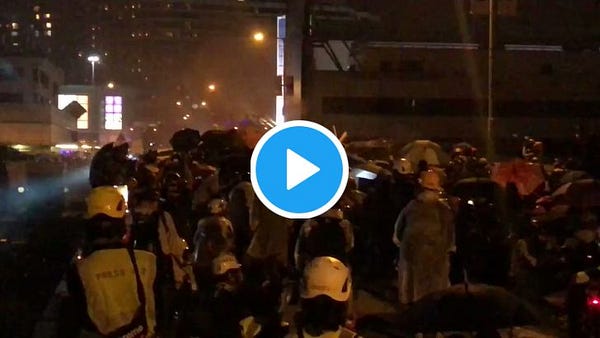
At almost the same moment, news began to come through that police were closing their cordon around the site and had declared that anyone remaining would be arrested for rioting. Police had apparently already refused first aiders and non-accredited journalists permission to leave. At the same time, I received a message from a reporter friend: “I hope u hv left.”
Ten minutes later, I had.
Rule of Law
Hong Kong’s rule of law was in the spotlight again this week, with the news on Monday that Hong Kong’s High Court had overturned the Carrie Lam’s face-masking ban.
Background for those who have not been following along: In early October Lam made use of the colonial-era Emergency Regulations Ordinance (not utilised since the 1973 oil crisis) to introduce a new regulation prohibiting the wearing of face coverings during any public gathering, lawful or unlawful. The anti-masking law was notable not only for its restrictions on civil liberties, but because in enacting the ban the executive branch of government had unilaterally decreed an entirely new criminal offence, bypassing legislative scrutiny.
On Monday the court ruled that Lam’s use of the ERO was inconsistent with the Basic Law and the Bill of Rights Ordinance. More than that, the court said that any use of the Emergency Powers Ordinance in cases of merely “public danger” is unconstitutional. While the government may still utilise the ERO in cases of “emergency” (presumably, following the declaration of a state of emergency), Lam has conspicuously refused to do that, going out of her way to declare that Hong Kong was not in a state of emergency, perhaps cognisant of the adverse PR impact.
The decision was a testament to the strength Hong Kong’s independent judiciary and a reassuring boost to the image of Hong Kong’s rule of law…which Beijing moved immediately to scotch, with a furious response. A spokesperson for the National People’s Congress condemned the court’s decision, and declared that the Hong Kong courts had no such power to rule on the constitutionality of Hong Kong laws and acts of government — never mind that Hong Kong courts had been doing exactly that for the 22 years since the Handover.
The essential underlying principle of the rule of law is that everyone, including the government itself, is subject to the law. The government’s lawmaking must itself be lawful (consistent with the constitution, which in Hong Kong’s case is the Basic Law). Under the three-way separation of powers doctrine — adopted in common law jurisdictions, including Hong Kong, and which Beijing explicitly rejects for the rest of China — the courts, through an independent judiciary, act as this check-and-balance on government power.
It is hard to tell whether the Beijing response is just bluster, or whether the National People’s Congress will actually move to make the necessary “interpretation” of the Basic Law to implement this restriction on the Hong Kong courts’ power. If they do, it is hard to understate the impact: it would completely & fundamentally alter the landscape of the Hong Kong legal system and could quite legitimately be said to mean the end of the rule of law as we know it in Hong Kong…
…something I spoke about with Sue-Lin Wong for an excellent piece she and Nicolle Liu wrote for the Financial Times: Hong Kong: “You either have rule of law or you don’t”. Sue-Lin quoted a few of the choice words I had to say about the police:
“It is outrageous that police officers who have shot people are not put on leave and an investigation of the circumstances of the shooting isn’t launched,” says Antony Dapiran, a Hong Kong-based corporate lawyer. “That happens everywhere in the world, including in the US where police shoot people all the time.” [With all due respect to any readers working in American law enforcement!]
[…]
“Part of what is happening right now in Hong Kong is that the police force is in the process of being co-opted by Beijing and is in the process of going from being accountable to the community that it polices to being enforcers of Beijing’s rule in Hong Kong,” says Mr Dapiran.
And also the rule of law:
“The moment you have opacity and unpredictability in one part of the legal system, it could easily apply to other parts of the system as well. The rule of law is an absolute,” says Mr Dapiran. “You either have it or you don’t.”
District Council Elections
District Council elections are due to be held this Sunday, 24 November. Voters will be electing representatives to each of Hong Kong’s 18 District Councils. Local council elections rarely inspire excitement in other parts of the world, so why are these so important? Two reasons:
Firstly, these elections are effectively a referendum, with the Pan-Democrat parties acting as a proxy for the protesters and the Pro-Beijing parties representing the government, police and, ultimately, Beijing. The results will be the best objective measure of exactly how the people of Hong Kong are feeling about the protests and where their sympathies lie.
Secondly, and even more importantly: the 208 Hong Kong/Kowloon district councillors and 223 New Territories district councillors each vote as a block to decide which 57, and 60, respectively of their number will sit on the 1,200-member Chief Executive Election Committee, which elects the Chief Executive. This is a “winner takes all” voting process: in the past, the pro-Beijing parties have controlled a majority of district council seats and so have decided who takes all of those Election Committee seats. If the Pan-Dems can win a majority of the district council seats this weekend, this will put them in the position to decide who will fill those 117 seats, an almost-10% bloc on that all-important Election Committee, and a possibility that filled pro-Beijing politician Regina Ip with such dread that she penned an entire SCMP op-ed warning against it. “The people are revolting,” indeed.
The government reportedly held a “crisis meeting” this evening to assess whether the elections will be able to go ahead, while protesters seem to have calmed things down the last couple of days to avoid giving the government any excuse to cancel the elections. Stay tuned.
In Closing
A touching moment I witnessed in the back streets of Tsim Sha Tsui on Sunday night as police pursued protesters through the streets and tear gas drifted across the neighbourhood:

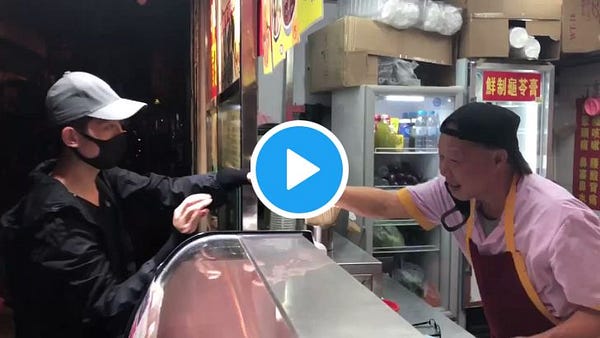
Some photographs from the “Siege of PolyU” on Sunday and the “Save PolyU” protests on Monday below.
This has been a Procrastination. Thanks for reading.
Antony
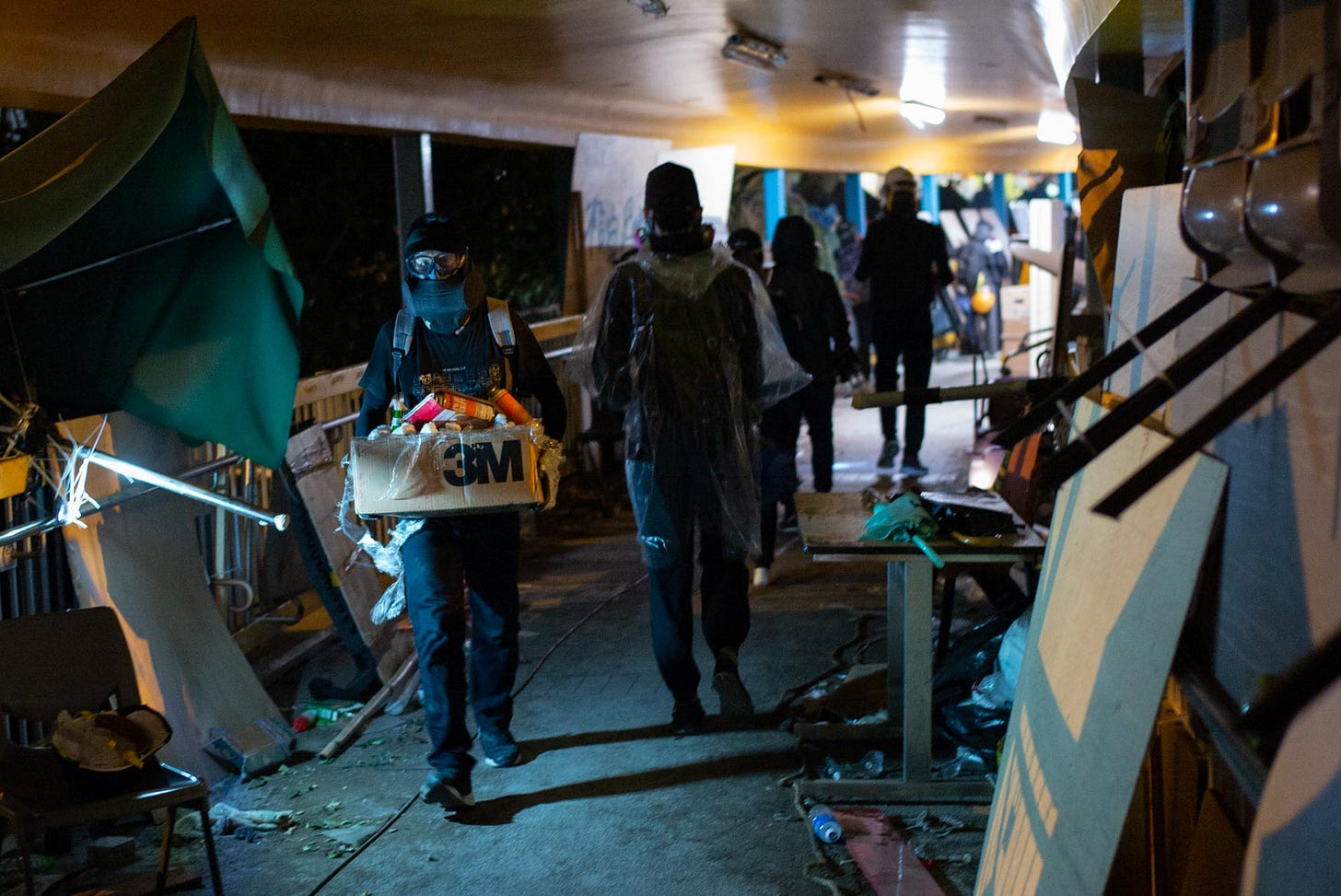
Protesters carry supplies along a fortified footbridge outside PolyU.
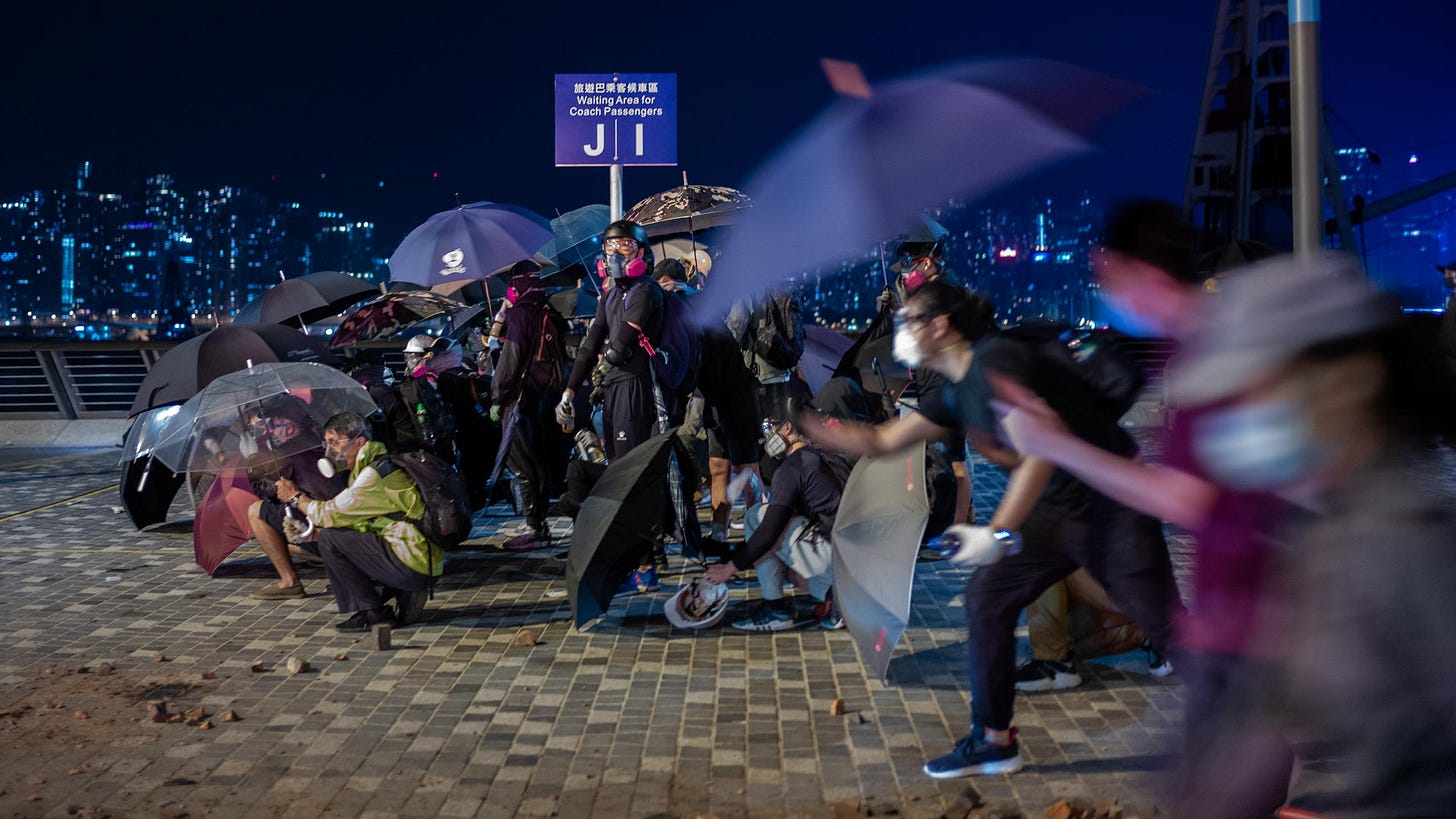
Protesters in the “Save PolyU” operation face police lines on the Tsim Sha Tsui waterfront.

Police pursue protesters down a Tsim Sha Tsui street.

Protesters in the Yau Ma Tei back streets.
Were you forwarded this email by a friend? Sign up below to receive A Procrastination direct to your inbox!



